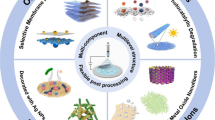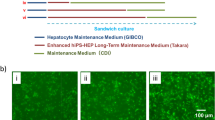Abstract
Feasibility of using a macroporous membrane material, expanded polytetrafluoroethylene (ePTFE), for culturing hepatocytes on its surface was examined. Adult rat hepatocytes were attached to an ePTFE surface and cultured in a hormonally defined medium supplemented with or without fetal calf serum (FCS, 10%) or bovine serum albumin (BSA, 0.03–3%). When cultured in a FCS-suplemented medium, hepatocytes reorganized themselves into multilayer cell aggregates on an ePTFE surface. The morphological characteristics of hepatocytes were influenced by the modification of the ePTFE surface as well as the culture medium. Hepatocytes cultured on a polyvinylalcohol (PVA)-coated ePTFE surface formed many more multilayer cell aggregates than those cultured on an uncoated ePTFE surface. Such highly multilayered hepatocyte aggregates were also noted when the cells were cultivated in a BSA-supplemented medium. On the other hand, when cultured in a FCS- or BSA-free medium, hepatocytes formed cell monolayers on both PVA-coated and uncoated ePTFE surfaces as did the cells on a collagen-coated polystyrene surface. The hepatocytes in the aggregates exhibited high albumin expression capability and low DNA synthesis rate as compared with those in monolayer cultures. The multilayer hepatocyte aggregates, as immobilized on a PVA-coated ePTFE surface in a serum-supplemented medium, are shown to be not only morphologically, but functionally differentiated, and will provide us a model system for the development of a bioreactor using hepatocytes, particularly for a hybrid-type artificial liver.
Similar content being viewed by others
References
Akaike T, Tobe S, Kobayashi A, Goto M and Kobayashi K (1993) Design of hepatocyte specific extracellular matrices for hybrid artificial liver. Gastroenterologia Jap. 28: 45–52.
Baldwin SP and Saltzman WM (1996) Polymers for tissue engineering. TRIP 4: 177–182.
Ben-Ze'ev A, Robinson GS, Bucher NCR and Farmer SR (1988) Cell-cell and cell-matrix interactions differentially regulate the expression of hepatic cytoskeletal genes in primary cultures of rat hepatocytes. Proc. Nat. Acad. Sci. USA 85: 2161–2165.
Enat R, Jefferson DM, Ruiz-Opazo N, Gatmaitan Z, Leinwand LA and Reid ML (1984) Hepatocyte proliferation in vitro: its dependence on the use of serum-free hormonally defined medium and substrate of extracellular matrix. proc. Natl. Acad. Sci. USA 81: 1411–1415.
Hirabayashi K, Saitoh H, Ijima H., Takenawa T, Kodama M and Hori M (1992) Influence of fibril length upon ePTFE graft healing and host modification of the implant. J. of Biomed. Mat. res. 26: 1433–1447.
Koide N, Sakaguchi K, Loide Y, Asano K, Kawaguchi M, Matsushima H, Takenami T, Shinji T, Moor M and Tsuji T (1990) Formation of multicellular spheroids composed of adult rat hepatocytes in dishes with positively charged surfaces and under other nonadherent environments. Exp. Cell Res. 186: 227–235.
Roberts RA and Soames AR (1993) Hepatocyte spheroids: Prolinged hepatocyte viability for in vitro modeling of nongenotoxic carcinogenesis. Fundamental and applied toxicology 21: 149–158.
Seglen PO (1976) Preparation of isolated rat liver cells. Methods Cell Biol. 13: 29–83.
Tong JZ, Sarrazin S, Cassio D, Gauthier F and Alvarez F (1994) Application of spheroid culture to human hepatocytes and maintenance of their differentiation. Biol. Cell 81: 77–81.
Tokiwa T, Kano J, Meng XY, Bahulekar R and Kodama M (1996) Formation of non-spheroidal aggregates by adult rat hepatocytes on polyacrylamide coated surfaces. Biotech. Tech. 10: 845–848.
Rights and permissions
About this article
Cite this article
Tokiwa, T., Kano, J., Kodama, M. et al. Multilayer rat hepatocyte aggregates formed on expanded polytetrafluoroethylene surface. Cytotechnology 25, 137–144 (1997). https://doi.org/10.1023/A:1007991111749
Issue Date:
DOI: https://doi.org/10.1023/A:1007991111749




